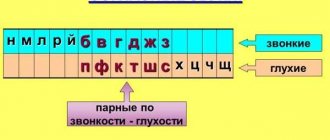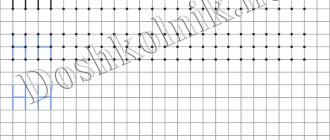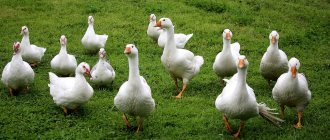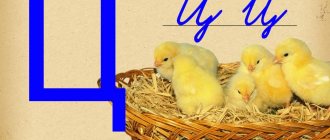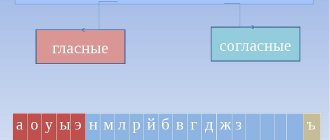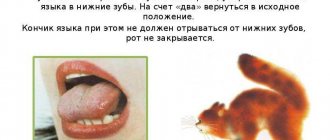Writing lesson notes for 1st grade. Uppercase and lowercase letter "g"
Subject: writing Class: 1 Lesson topic: Uppercase and lowercase letters “r”. Writing syllables, words, sentences. Lesson type: learning new material Purpose: creating favorable conditions for writing the lowercase letter “g”. Objectives: 1. To help students become familiar with the written lowercase letter r. To develop the graphic skill of writing the letter r. 2. To promote the correction and development of spatial orientation. Promote the development of fine motor skills of the hands. 3. Contribute to the development of positive motivation for the learning process. During the classes. 1. Organizational moment. The bell rang and stopped, We are starting the lesson. They smiled, pulled themselves up, looked at each other and sat down calmly, quietly. 2. Setting the goals and objectives of the lesson. Teacher: Today in class we will learn how to write a new letter, and which one you will find out by guessing the riddle. These birds by the ditch often wash their paws and run away from grandma. Who will say this? Students: Geese. Teacher: What is the first sound we hear in the word geese? Teacher: Today we will learn how to write the lowercase letter g. To write correctly, we will do a warm-up for our hands. 3. Finger gymnastics. They spank in single file (Spank on the back of the hand) Gander after gander (Depict the hands of a goose) Look from high Gander at gander Oh, pinches the sides (Pinch with 1 hand 2) Gander at gander. 4. Speech gymnastics The gray geese flew and sat quietly on the lawn. Walked around and pecked. Then they quickly ran. “Swing” “Mushroom” Clapping “Needle”, “Jam” Clapping 5. Studying new material. Teacher: Let's remember how to hold a pen correctly. Students: I hold the pen correctly. I put it on the middle finger. I gently press with my thumb and lead with my index finger. Teacher: Tell me, what do geese like to do? Students: Swim Teacher: Why do they like to swim? Students: By water Teacher: Let's imagine that our work line is a river along which geese swim. Show the top line of the working line in the air, the bottom line. (Students show in the air the top line of the working line, the bottom.) Teacher: Let’s place a pen in the air at the beginning of the line and begin to write in a wave-like motion up and down. Teacher: Open your notebooks and color in your work line from top to bottom. What color pencil should we take? Students: Blue. Teacher: Why? Students: Because the sound g is a consonant. Teacher: We have a river for geese. And the geese hid. Take a pen and trace. Teacher: What kind of birds did we get? Students: Geese. Teacher: What is the first sound of the word geese? Students: G. Teacher: Let's see if they look like the real ones? Students: Yes. Teacher: Say the word geese. Look and tell me what letter does the word geese begin with? Students: G. Teacher: Is the letter G printed or written? Students: Printed. Teacher: Now look, what letters are on the left? Students: Printed. Teacher: And on the right, which ones? Students: Written. Teacher: Where do we see block letters? Students: In the book. Teacher: And in notebooks, which ones do we write down? Students: Written. Teacher: Look how the lowercase letter g is written. How many elements does it consist of? Students: From 1 element. Teacher: What is the name of this element? Students: An inclined line with a curve on both sides. Teacher: I start writing just above the middle of the working line from bottom to top. Having reached the top line, I round it to the right and write a slanted line. Having reached the bottom line, I round to the right and write a rounding that ends before reaching the middle of the working line. Look again. And, once, and. Look, there is a card on your desk. It depicts a river and geese, but trouble happened to them, part of each goose disappeared. We need to help them, write them down. Now try to write this letter on the board. 6. Physical minute The gray geese flew (running in place, moving their arms like wings) Yes they flew, yes they flew, And they sat down and sat (doing squats) And they flew again (running). 7. Independent work. Teacher: We learned how to correctly write the lowercase letter g. And now it’s time to write it in a notebook. Teacher: How do our geese cackle? Let's read it. Students: ha, ha, ha. Teacher: Which syllable is repeated? Students: ha. Teacher: How many times is it repeated? Students: 3 times. Teacher: Let's write this syllable 3 times. Teacher: And who cackles: ha, ha, ha? Students: Geese. Teacher: Let's break it down into syllables. (gu – si) Write as many syllables gu as syllables ga. Teacher: Let's say the word geese again. How many syllables does it have? Students: 2. Teacher: How many sounds? Students: 2. Teacher: What sounds? 1? 2? 3? 4? Students: g, u, s, i. Teacher: Color in the diagram. Let's check. Write down the word. Teacher: Let's make a sentence with this word. And the question will help us: Where are the geese? Students: There are geese in the meadow. Teacher: Read the sentence in your notebook. Did we formulate the proposal correctly? Students: Yes, that's right. Teacher: Write this sentence down on the line below. Teacher: Let's draw a diagram for it. What do we need to know for this? Students: We need to know how many words there are in a sentence. Teacher: How many words are there in it? Students: 3. Teacher: How is 1 word written? Students: 1 word is written with a capital letter. Teacher: How are the rest written down? Students: With a small letter. Teacher: What comes at the end of a sentence? Students: Put a period at the end of the sentence. Teacher: Draw a diagram of this sentence. 8. Summary. Reflection. Discussion.
Teacher: What letter did you learn to write? Students: We learned to write the lowercase letter r. Teacher: How many elements does it have? Students: 1 element. Teacher: Which one? Students: An inclined line with a curve on both sides. Teacher: Now show me a red pen if you liked it and a green pen if you didn’t like it.
We recommend watching:
Lesson summary of the surrounding world in 1st grade Lesson - travel. Teaching literacy in 1st grade. Lesson notes on teaching literacy in 1st grade. Consolidation of what has been learned Russian language lesson notes for 1st grade with presentation. Speech development. Suteev “Three kittens”
Similar articles:
Didactic games in Russian language lessons in elementary school
Extracurricular lesson in Russian language, grades 1-2
Lesson notes on the Russian language, 1st grade. Consonant sounds. School of Russia
Lesson notes on the Russian language, 1st grade. Hard and soft consonants
Lesson notes on the Russian language, 1st grade. Spelling letters denoting paired consonant sounds at the end of words
A tale of words starting with the letter G
A fairy tale, as a piece of folklore, always helps with the development of speech, as well as during the correction of speech disorders.
You can come up with fairy tales with your children on the go or prepare them in advance. But you also need to come up with a task for the fairy tale.
Just listening will be of little use in producing sounds.
For example, you can invite your child to draw sticks while listening when he hears the sound Г or Гь.
This will contribute to the formation of auditory attention, which is important when we work with sound production.
I offer a short fairy tale of words that begin and also contain the letters G in different parts of the words. This is just an example of how such fairy tales - exercises - are composed.
To make it easier to compose a fairy tale, you need to make a list of words with the letter G in advance. They are distributed in three columns: nouns, adjectives, verbs.
Words can alternate - ordinary ones with fictitious and non-existent ones. This way the fairy tale will be perceived easier and funnier. But it is humor that contributes to better learning of any educational material.
For my fairy tale, I first came up with the following groups of words:
Now, in a random order, under inspiration and guided by our own imagination, we come up with a simple fairy tale plot. The funnier the better.
A dove and a goose chased a proud hot water bottle through a dense city. The proud warmer looked with all her eyes at the goose and dove, blue lips, blue eyes. The goose says to the proud warmer: “There is no need to stroke the peepers.” The main one here is the Dove. He loves and pets everyone. Only he strokes his eyes and lips.” The dove is not proud. He drove and drove the proud hot water bottle, and then stroked her eyes. The proud hot-water bottle doesn't look proud now.
Automation of G in the classroom
Children's institutions organize speech classes, consultations and classes with a speech therapist, as well as regular articulation exercises.
The lesson summary below lists those few exercises that can be included in your plans for practicing hard and soft G sounds in preschool children.
It is advisable to keep a card index of such exercise games for each sound and constantly refer to it during correctional activities.
In everyday activities with children, as well as during other activities, it is important to carry out speech warm-ups from time to time.
For example, you can set a goal to introduce pure language with sounds every day.
Below I have attached a list of words classified by the number of letters for practicing the sound pronunciation of G.
Sound and letter G. Literacy lesson in the preparatory group
Learning to read and write
Topic: Sound and letter G Purpose:
Goals: to continue studying the letters of the Russian alphabet;
introduce students to new sounds [g], [g'] and the letters G, g, denoting these sounds in writing; develop reading skills; improve the skills of syllabic and sound-letter analysis of words; promote the development of thinking, speech, phonemic hearing, the ability to perceive and understand what is read; cultivate interest in learning and reading. Progress of the lesson Organizational moment
The long-awaited call was given.
Don't doze off in class, He called us to class! Grab knowledge faster. Everyone sit down quietly, children, so that there is no hassle, we agree not to make noise, are you all ready for the lesson? It’s beautiful to raise your hand, Then, without wasting time, Answer clearly, okay, We’re starting a literacy lesson. Statement of the topic and goals of the lesson
Today in the lesson we will get acquainted with new sounds and the letters that represent them, we will read syllables and words with new letters.
Repetition of the material covered - What letter did we learn about in the last lesson? Characteristics of sound. Studying new material Riddles:
There was a knocking, a rustling sound, There was a rustling noise under the table... In a red hat, with a beard, The tablecloth was pushed aside...
(dwarf).
Long neck, red paws, Pinches your heels, run without looking back.
(Goose) -
Who is this?
How did you guess? How do geese cackle? Let's say the words of the answer and listen to them. Are all sounds familiar to us? What sound is unfamiliar? Today in class I propose to play explorers. We will explore the sound G and characterize it. Sound characteristics: Consonant, hard, soft, sonorous. Create a sound model for the word “goose”.
(one student works at the board ). Check if your model is like this?
How many syllables are in the word "goose"? Why? Well done! You know how to create a sound diagram of a word. Listen to the poem by S. Marshak, try to remember words with the sounds [g], [g'].
Here are geese with a brood of goslings, making noise and hissing like snakes.
They threaten the truck, craning their necks. But the truck is not afraid of a flock of loud-mouthed geese. He threatens the gander with a horn, clearing the road. What words with new sounds did you remember? Well done! Everyone was attentive and correctly remembered the words with new sounds. Sound analysis of the word: Guitar
We all love to listen to how Tamara sings with us, And in her hands the Six-string is obedient... (guitar) Physical education minute. Introducing new letters. Teacher. In writing, the sounds [g] and [g'] are denoted by the letter “ge”. These are the block letters "ge". Why are there two of them? What does the letter "ge" look like? In front of you is the letter G. He carried the letter on his shoulders and stands like a poker. I was mowing the grass in the meadow. G is an ordinary hook, G is similar to a heron in appearance, but a faithful assistant in work. And he stands on one leg. Writing the letter “ge” in the air and typing it in notebooks. Reading words and syllables. Lesson summary: Well done, guys! Our lesson has come to an end. What new or interesting things did you learn in the lesson? What did you study?
